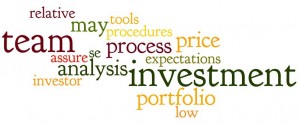Posted by Anu Heda
on May 25, 2011,
in
Thoughts
, tagged with
BlackRock,
Dodge & Cox,
Janus,
MFS,
PIMCO,
Pyramis,
Risk Management,
Vanguard,
Western Asset
In our consulting work, we meet marketing executives wanting to extol their firm’s risk management practices. Risk management poses a specific problem. Stay to high-level and it sounds like you don’t manage risk. Discuss procedures and controls and risk losing your audience.
Below is copy taken directly from three industry leading firms: Western Asset, Janus, and Dodge & Cox. Great firms struggle to convey a straightforward process. Many firms – BlackRock, MFS, PIMCO, Pyramis, & Vanguard – don’t emphasize the topic on their public Web sites. Any of the below copy strike a chord with you?
We’re curious what you think should be conveyed when discussing risk management. Send us an e-mail or message via Twitter. I pasted all that copy into a word cloud software to see what words are most common: risk management is often described with the words “investment” and “team” (note: I excluded “risk” and “management.”)
Western Asset
Western Asset has a dedicated risk management team that oversees risk management and incorporates it into the investment process. While this team is integrated into the portfolio management unit, it has a separate and independent reporting structure. Western’s risk management team combines the best of the Firm’s technology and experience to develop useful risk management tools and procedures. These tools and procedures provide daily analysis for both the Investment Team and the Analytics/Risk Management Department, ensuring the integration of professional risk management practices into the investment process.
Janus
The Janus Risk Management team, headed by Dan Scherman, serves as a resource for portfolio management to assure that every portfolio maintains the appropriate level of risk given its performance objective. Additionally, the team helps to assure that risks taken are associated with intended bets.
Tools used to monitor risk include:
- Tracking error decomposition, characteristics, concentration, Janus ratings, under-weights/over-weights
- SPAR returns-based style analysis
- Performance attribution (Factset, BARRA, Wilshire)
- Index and competitor analysis, as necessary
Dodge & Cox
From the earliest days, Dodge & Cox’s investment approach has stressed evaluation of risk relative to opportunity. A strict price discipline — steering clear of popular choices that come at a price premium we would rather not pay — is critical to achieving our investment objectives. Low valuation investments, for example, typically reflect low investor expectations that may serve as a buffer against the risk of significant price decline; these low expectations may also create greater potential for capital appreciation should investor pessimism turn out to be unwarranted or short-lived. At all times, our ongoing search for superior relative value is guided by a rigorous research process that seeks to differentiate the short-term concerns that may be temporarily depressing an investment from the intractable, long-term problems that could doom it.








